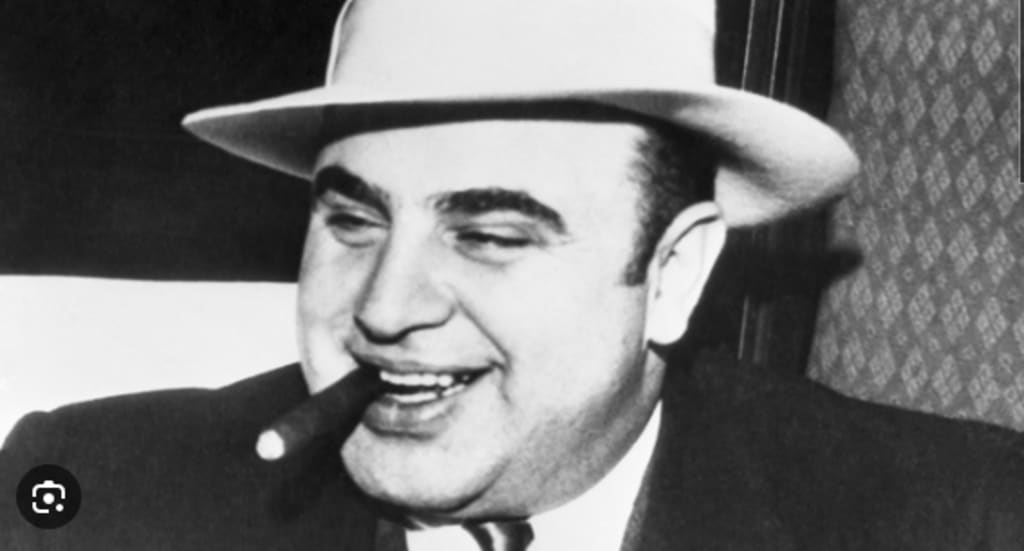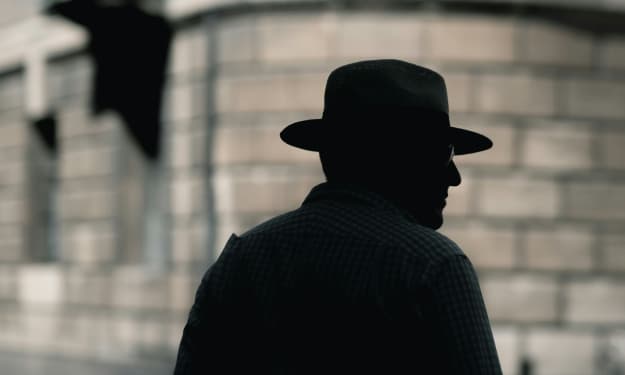Great Chicago Novel
Chapter One

Me, Al Capone, one of the most infamous figures in American history. I am indelibly linked to the city of Chicago. As a prominent gangster during the Prohibition era. I rose to power through bootlegging, gambling, and other illegal activities. My reign in Chicago during the 1920s and early 1930s left an indelible mark on the city's history. Earning it the moniker of "Capone's Chicago."
I was born on January 17, 1899, in Brooklyn, New York. My name is Al Capone, also known as "Scarface". My parents, Gabriele Capone and Teresa Capone, were Italian immigrants. My father worked as a barber and my mother was a steamstress. They both came from Angri, a small town outside of Naples in the Province of Salerno. Our family initially lived at 95 Navy Street in the Navy Yard section of Brooklyn. However, when I was 11 years old, we moved to 38 Garfield Place in Park Slope, Brooklyn. Along with me, my parents had 8 other children: James Vincenzo Capone, who later changed his name to Richard Hart and became a Prohibition agent in Nebraska; Raffaele James Capone, also known as Ralph Capone or "Bottles," who took charge of my beverage industry; Salvatore "Frank" Capone; Ermina Capone, who sadly passed away at the age of 1; Ermino "John" Capone; Albert Capone; Matthew Capone; and Mafalda Capone. Ralph and Frank were instrumental in working with me and my criminal empire!
I demonstrated potential as a student, but experienced difficulties adhering to the strict rules of my parochial Catholic school. My academic journey concluded at the age of 14 when I was expelled for striking a female teacher in the face. WHAP!!! To sustain myself, I found employment in various odd jobs throughout Brooklyn, such as working at a candy store and a bowling alley. Between 1916 and 1918, I participated in semi-professional baseball. Consequently, I crossed paths with gangster Johnny Torrio, who became a significant influence and mentor in my life.
I tied the knot with Mae Josephine Coughlin when was just 19 years old, on December 30, 1918. Mae is of Irish Catholic descent and had recently given birth to our son, Albert Francis "Sonny" Capone (1918). Unfortunately, Albert lost most of his hearing in his left ear during his childhood. Because I was still underage, had to obtain written consent from his parents for the marriage to take place. Although I led a criminal lifestyle, the marriage was to be a content and fulfilling one.
New York
I initially became involved with small gangs, such as the Junior Forty Thieves and the Bowery Boys. I later joined the Brooklyn Rippers and eventually the influential Five Points Gang in Lower Manhattan. During this time, I worked under the guidance of fellow racketeer Frankie Yale, who was a bartender at the Harvard Inn, a dance hall and saloon in Coney Island. While I was working as a doorman, I unintentionally offended a woman, resulting in her brother, Frank Galluccio, slashing me three times on the left side of his face. These wounds earned the nickname "Scarface," which I disliked. When being photographed, I made sure to conceal the scarred side of his face, claiming the injuries were from war. Among my closest friends, I was referred to as "Snorky," a term for a well-dressed individual.
Chicago
I moved to Chicago in 1919, at the age of 20, to join the criminal underworld. The Prohibition law, which banned the sale and consumption of alcohol, had just come into effect, creating an opportunity for enterprising individuals like me to build illegal empires. I quickly climbed the ranks within the Chicago Outfit. A powerful organized crime syndicate led by Johnny Torrio.
Upon receiving an invitation from Torrio, I departed from New York City to settle in Chicago and work under crime boss James "Big Jim" Colosimo as an enforcer. I initiated his journey in Chicago by taking on the role of a bouncer at a brothel, which is believed to be the probable source of my contraction of syphilis. Despite being aware of my infection at an early stage, I never sought treatment, even though timely use of Salvarsan could potentially have cured me. I made a significant move in 1923 when I acquired a modest residence located at 7244 South Prairie Avenue in Chicago's Park Manor neighborhood for a sum of US$5,500.
Based on the Chicago Daily Tribune, it was reported that on May 7, 1923, Joe Howard, a hijacker, met his demise while attempting to interfere with mine and Torrio's bootlegging enterprise. During the earlier years of the decade, my name began making appearances in newspaper sports pages, where was identified as a boxing promoter. After Colosimo's assassination on May 11, 1920, an incident wherein I was suspected to be involved, Torrio assumed control of Colosimo's criminal empire. Torrio, with me as his trusted aide, led the most sizable Italian organized crime group in Chicago. In his role, Torrio exercised caution to avoid getting entangled in gang disputes, constantly striving to negotiate territorial agreements between rival criminal factions. Despite my deceptive claims of being a mediator in disputes, he provided minimal support in resisting the Genna brothers' encroachment on the smaller North Side Gang, led by Dean O'Banion. Consequently, on November 10, 1924, Torrio strategically orchestrated the murder of O'Banion at his flower shop, establishing Hymie Weiss as the new gang leader, supported by Vincent Drucci and Bugs Moran. Notably, Weiss and O'Banion had shared a close friendship, making the North Siders prioritize seeking revenge against O'Banion's assassins.
During the Prohibition era, I formed alliances with Canadian bootleggers who assisted me in smuggling alcohol into the United States. When asked about his familiarity with Rocco Perri, allegedly known as Canada's "King of the Bootleggers," I quipped, "Why, I don't even know which street Canada is on." Nevertheless, the Royal Canadian Mounted Police denies the existence of any evidence supporting of my physical presence on Canadian soil.
I frequently sought the assistance of local members of the African American community for his operations. Notably, jazz musicians Milt Hinton and Lionel Hampton had relatives who worked for me on Chicago's South Side. Me, a jazz enthusiast. Once challenged clarinetist Johnny Dodds to play a tune that Dodds was unfamiliar with. As a reward, I split a $100 bill in half and promised Dodds the other half once he learned the tune. Additionally, I provided two bodyguards for jazz pianist Earl Hines during a road trip.
Alongside his criminal enterprises, I enjoyed a luxurious lifestyle filled with tailored suits, cigars, gourmet food and drinks, and the company of women. I became renowned for my extravagant and expensive jewelry. When questioned about my activities, I often responded with statements like "I am simply a businessman fulfilling the desires of the people" and "All I do is meet a public demand." As a result, I gained nationwide fame and became a topic of discussion.
I established base of operations in Cicero, Illinois. Through bribery and widespread intimidation, I took control of town council elections, making it challenging for rival gang, the North Siders, to target me. Despite their efforts, I remained elusive. However, my driver was later found tortured and murdered, and an assassination attempt was made on rival gang leader Weiss in the Chicago Loop. The North Siders devised a plan on September 20, 1926, outside my headquarters at the Hawthorne Inn to draw him to the windows. Gunmen in multiple cars unleashed a barrage of gunfire from Thompson submachine guns and shotguns towards the restaurant's windows on the first floor. Miraculously, I escaped unharmed and called for a truce, but the negotiations ultimately failed. Three weeks later, on October 11, Weiss was killed outside the North Siders' headquarters at O'Banion's former flower shop. In a later incident, Moran and Drucci kidnapped and murdered the owner of Hawthorne's restaurant, who happened to be a friend of mine in January 1927.
In November 1925, my consigliere, Antonio Lombardo, assumed leadership of the Unione Siciliana, a benevolent society for Sicilian-Americans that had been infiltrated by gangsters. Joe Aiello, who had desired the position for himself, became enraged and believed I was behind Lombardo's promotion. Aiello, a non-Sicilian, resented my attempts to manipulate the Unione's affairs and severed all ties with Lombardo, sparking a feud with me.
To exact revenge, Aiello joined forces with other enemies I such as Jack Zuta, with whom he operated vice and gambling establishments. Aiello devised multiple murder plots targeting both Lombardo and me and made several attempts on my life starting in the spring of 1927. In one instance, Aiello tempted the chef at Joseph "Diamond Joe" Esposito's Bella Napoli Café, my favorite restaurant, with a bribe to poison m and Lombardo's soup with prussic acid. However, the chef instead exposed the scheme to me. In retaliation, I ordered his men to unleash a hail of gunfire on Aiello's bakery on West Division Street, leaving Joe's brother Antonio injured.
During the summer and fall of 1927, several hitmen hired by Aiello to eliminate were themselves assassinated. This included Anthony Russo and Vincent Spicuzza, who were each offered $25,000 by Aiello to kill me and Lombardo. Eventually, Aiello raised the bounty to $50,000 for anyone who succeeded in killing me. However, at least ten gunmen who attempted to collect on the reward met their demise instead. Ralph Sheldon, an ally of mine, also tried to kill both me and Lombardo in pursuit of Aiello's reward, but I associate Frank Nitti's intelligence network discovered the plot. Sheldon was shot in front of a hotel on the West Side but survived.
In November 1927, Aiello orchestrated machine-gun ambushes near Lombardo's residence and a cigar store frequented by me. However, an anonymous tip led the police to raid several locations, resulting in the arrest of Milwaukee gunman Angelo La Mantio and four other members of Aiello's gang. When the police found apartment receipts in La Mantio's possession, he confessed that Aiello had hired him to murder me and Lombardo, leading to Aiello's own arrest and detention at the South Clark Street police station. Upon learning of Aiello's arrest, I deployed nearly two dozen gunmen to guard the station in anticipation of Aiello's release. The gunmen made their purpose clear without any attempt to conceal it, drawing the attention of reporters and photographers who anxiously waited to witness Aiello's expected demise.
My rise to dominance, came after a series of violent confrontations with rival gangs. This event solidified my reputation as a ruthless and dangerous mob boss.
Despite my involvement in countless criminal activities, I proved to be a master at manipulating public perception. I cultivated an image of a charitable and community-minded individual. I would often distribute food to the poor during the Great Depression, further enhancing public persona. However, behind the facade of philanthropy, I was responsible for numerous murders, extortions, and other heinous acts.
I remain one of the most notorious American gangsters of the 20th century, and my story has been extensively covered in numerous articles, books, and films. Particularly between 1925 and 1929, shortly after my moved to Chicago, me held the title of the most notorious mobster in the entire country. I skillfully crafted a specific image of himself in the media, making him a captivated figure of intrigue. My personality and character have served as a model for crime lords and criminal masterminds in fictional works ever since his demise. The iconic depiction of a mobster donning a pinstriped suit and a tilted fedora is derived from actual photographs of me. Furthermore, my accent, mannerisms, facial features, physique, and parodies of his name have been associated with numerous gangsters in comics, movies, music, and literature.
In conclusion, my time in Chicago remains a captivating and cautionary tale of how one man's thirst for power and wealth led to a reign of violence and corruption. My name will forever be linked to the city, "Al Capone" leaving an unforgettable mark on Chicago's history. Untold!
This is a early tale on my life story. Read Chapter Two an I will tell you more!!
About the Creator
marie e ehlenbach
I started writing when I found my imagination needed a place to be! Yes, I will write about anything that comes to mind! Living near the National Park in Washington, DC. I find it is the place to go to let your imagination take over!






Comments
There are no comments for this story
Be the first to respond and start the conversation.